BY JEFFREY RESSNER
Photographed by Derek Hudson
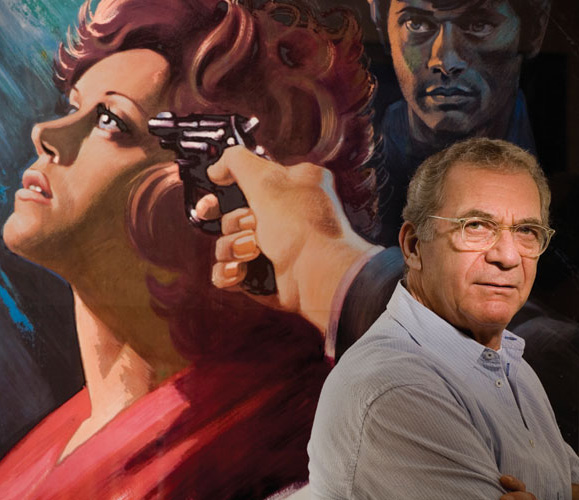
Perhaps no contemporary filmmaker deserves the sobriquet “actor’s director” more than the 72-year-old Sydney Pollack. Actors in his films have garnered 12 Oscar nominations and he’s worked closely with the biggest stars in the world–Redford, Streep, Cruise, Hoffman, Pacino, Newman, Kidman and Penn. He’s always favored strong performances over stylistic camera flash. “If you’re doing long dialogue scenes with two people, you just get in the way if you start shooting from the floor up the actor’s nose,” he says with his characteristic humor. But this old school professional is also a “directing actor.” He got his start on the boards, appeared in several early TV series, and has been on both sides of the camera in several of the 20 films he’s helmed. (Dustin Hoffman insisted Pollack take on the role of his agent in
Tootsie in 1982, after a two-decade hiatus from acting.)
Blessed with early mentors including revered acting guru Sanford Meisner, enfant terrible director John Frankenheimer and legendary film star Burt Lancaster, the Indiana native directed TV shows such as The Alfred Hitchcock Hour, The Fugitive and Ben Casey before tackling his first feature, The Slender Thread, in 1965. Since then, his craftsman’s touch and attention to storytelling have elevated numerous mainstream projects. This year, the quintessential Hollywood pro recaptured the spontaneity and shoot-from-the-hip quality he learned in live television almost 50 years ago with his film Sketches of Frank Gehry, an ode to the legendary architect and longtime friend. It marks the director’s first documentary and also the first time he’s worked with a $1 million budget since the mid-sixties.
The winner of two Academy Awards for Out of Africa, three DGA Award nominations and the John Huston Award for Artists Rights at DGA Honors, Pollack’s statues and plaques are on display in the hallway of his bright first floor office on Sunset Boulevard. Still fit and youthful, decked out in a white T-shirt, jeans and black cowboy boots, he sat for the DGA Interview shortly before heading to Cannes for the out-of-competition screening of his documentary. It seemed only logical to begin with a nod to his insightful portrait of another artist’s creative process.
JEFFREY RESSNER: When the documentary Sketches of Frank Gehry opens, we simply hear your voice curiously asking him, ‘Is starting hard?’ So let’s begin there, as it relates to directing: Is starting hard?
SYDNEY POLLACK: Yeah, it always is. When I say that in the Gehry documentary, I’m talking about his designs–he’s got a job, he’s already accepted the commission, and now he has a blank piece of paper and he’s going to start with a sketch. When I start, I already have a script. The start for me is usually how to rewrite, because I’ve never shot the script that I started with. I don’t start with a blank piece of paper, which to me is frightening.
Q: So what draws you to a script?
A: Most of the time, I get attached to the world in which the film takes place, and maybe one or two characters. It’s a question of finding something that makes me curious enough to want to stick with it for two years. There are a lot of movies that I would take two hours to see, but making one takes two years. To not get bored six months or even a year in is asking a lot of a particular subject, particularly at this stage of my life.
Q: After some rough sketches, Gehry starts cutting and bending strips of silver cardboard to make early models of his buildings. What’s your analogous process with film?
A: I use a lot of crutches and tools. I’m one of those unfortunate people who’s always rewriting, even when I’m shooting. It’s not a good, healthy thing to do. It drives the studios crazy. It drives production managers and the line producers crazy. It drives the actors crazy. I’ve been trying to discipline myself my whole life and I can’t. I’m not a director who works everything out and then shoots. I’m sort of discovering the movie as I’m making it. Of course I know the world I’m going for, but from moment to moment there’s fluidity in the shape of the film as I see dailies, get to know the actors, and go on the set every day.
Q: Given that methodology, how do you prepare for setting up shots or lighting in advance?
A: I’ll talk with the crew and cinematographer roughly about how we’ll shoot a scene. What has to be prepared has to be prepared: you have to pre-wire the set, know how many lights you’ll need, and get the equipment you need. I wouldn’t dare stall on that kind of stuff. I’m not talking about the type of improvising that costs a lot of money. I give the cameraman a setup every night before I go home. But I may go in the next day and suddenly say, ‘instead of shooting inside, I’d like to shoot from the terrace outside and not hear the characters through the window.’ It’s the kind of freedom I’ve got to have.
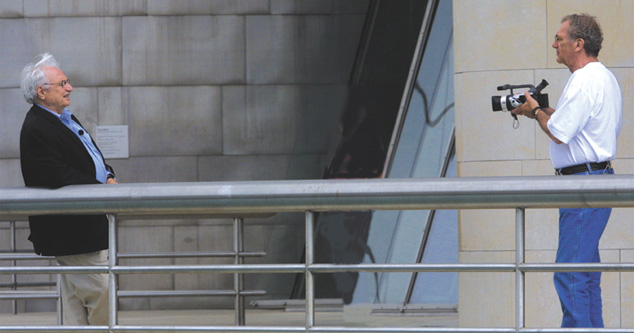 SKETCHES OF FRANK GEHRY (2005): Pollack shooting his friend
SKETCHES OF FRANK GEHRY (2005): Pollack shooting his friend
in front of the Walt Disney Concert Hall. (© David Strick)Q: You started out as an actor, how did you get into directing?
A: I didn’t know I wanted to be a director early on. I was talked into it. I was working as an actor with John Frankenheimer on Playhouse 90 live. It was a two-part Hemingway adaptation of For Whom the Bell Tolls–and he found out I had been Sanford Meisner’s teaching assistant. He was terribly impressed–I’m sure more impressed than he was with my acting. But he took me aside and said he was about to do a very important Playhouse 90 that was the first television appearance of Ingrid Bergman. It was Turn of the Screw by Henry James, and there were two young kids in it that weren’t professional actors. He asked me to work as a dialogue coach for him while he was busy with Bergman and the adults. Later, when he got his first really big movie, The Young Savages [with Burt Lancaster], there were three young kids who played juvenile delinquents and he hired me again. That’s what brought me out here to Hollywood. Lancaster said to me ‘you should be a director.’ I reluctantly said, ‘okay, I wouldn’t mind trying that.’ Then he set up an appointment for me to meet Lew Wasserman, and that’s how I became a director.
Q: What was it like working on the set with Frankenheimer in those days?
A: John always had a great sense of theatricality. And he was a real shooter. He had a wonderful sense of lenses and where to put the camera. Those were the early days of transitioning from live television into film, and John was always breaking cameras. We used these electric cameras that had tubes in them, and you couldn’t put them cockeyed on the floor because they’d heat up and blow out. But John was always putting them in impossible positions because it was a big part of his style, those unorthodox setups. Of course, everybody that learned in those days was into wide angles and low angles. You put the camera on the floor and you used wide-angle lenses and you shot up and you put ceiling pieces in, and that was a big deal. Because in the old days of lighting, you had to leave the ceiling open for lights–the film was slow, the lenses were slow.
Q: With almost a half-century of directing behind you now, what do you recall about your first directing job, an episode of Shotgun Slade?
A: I was terribly insecure. I remember I got up in the morning when it was still dark outside. I drove out to Universal Pictures, parked on the backlot, and waited until the sun came up. I saw all these trucks and equipment heading towards this set and the crew arrived and was saying ‘what do we do?’ I was completely panicked. I thought, ‘Well, I’m going to have to pretend I know what I’m doing here.’ I had plans up the wazoo, ten thousand sketches, and other things–none of which worked, of course, because I knew nothing about cameras. For the first couple of years that I worked as a director, I felt like I was acting the part and pretending. That feeling slowly went away, but I won’t even say I’m comfortable today. The thing that still gives me the most anxiety in the world is directing a movie.
Q: Is television still a good training ground for feature directors?
A: It was the only training ground when I started. We were stuck in a Catch-22 then. Nobody would give you a job unless they saw your work, and nobody could see your work unless they gave you a job. It cost too much money and was too big a gamble to let someone direct a movie without any proof they could do it, so it was very hard to get that first break. Today you can shoot a whole movie with a fairly inexpensive digital camera and edit it on your home computer. And they can look pretty damn good.
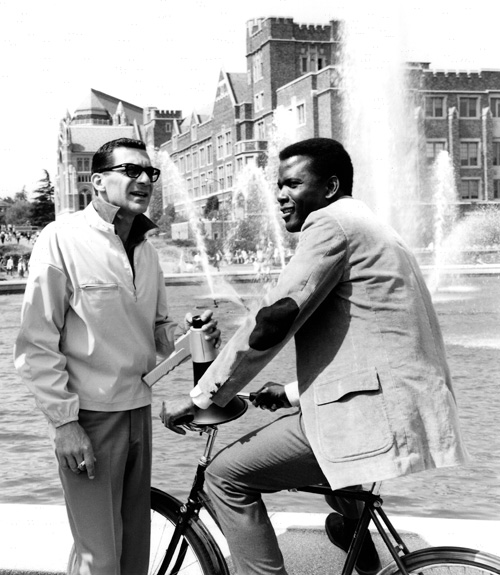 THE SLENDER THREAD (1965): Pollack on the set of his first
THE SLENDER THREAD (1965): Pollack on the set of his first
feature with Sydney Poitier. (© AMPAS)Q: You’ve done your fair share of camera work yourself. In the Gehry film you work much of the equipment and in They Shoot Horses, Don’t They? you donned roller skates to follow actors with a handheld camera. Is actual shooting something you do often?
A: It depends where I’m working, because there are union rules. If we need a second or a third camera, I’m quite capable of operating it. Sometimes, if I don’t know what precisely is going to happen in, say, an action scene or a fight scene, I might ask permission to operate the camera. But I’ve never done a movie where I’m the principal operator like Soderbergh or Lelouch. If I was working in Europe or making a small guerrilla movie, I might enjoy that.
Q: Is there a big difference in shooting digitally rather than on film?
A: Oh yeah. It’s all the difference in the world. The joke is that you don’t need a cameraman anymore because you can fix everything later on. That’s not really true at all, but what you can do digitally now is so astounding. Shooting on digital for me was essential in the documentary because it didn’t have to do with how it looked, except for the architecture, which I wanted to do in very special light, so that I shot in Super 16 with cameramen and gaffers and all that. But the interviews had really to do with candor and truth and unselfconsciousness and the only way I could get that was to not show up with a crew. You can’t ask a guy deeply personal questions about his process with 20 people standing there staring at him and a lot of lights. So the decision was to accept a lack of photographic quality in return for the truth. It was really shot on a home mini-DV camera. I liked the freedom of that. I liked that I didn’t have to worry about shadows and spend hours [setting up]. I could just ask questions and if he got up and moved I could follow him.
Q: On the other hand, you’re a big fan of Panavision cameras.
A: I got involved with widescreen Panavision in its infancy. I love that wide format, not because of the obvious conventional reason for using it, which is its impressive size. I like it because I could get more information about places on the screen. For the most part, I make relationship movies, mostly love stories that are more often than not about two people I’m trying to study. I was able to be fairly close to the two people and still have the sense of the environment using widescreen, which is hard to do in 1.85. I shot films like They Shoot Horses, Don’t They? in widescreen, even though it all takes place on one set. The studio came to me and said ‘what are you doing this in widescreen for? You’re not out in the Grand Canyon.’ I kept saying ‘it’s because I don’t ever want to lose the sense of all these other people dancing, or the audience watching, or the band playing.
The one movie that I should have used widescreen on and didn’t was Out of Africa. By that time, I was so pissed off at watching years of my movies getting screwed over by pan and scan that I couldn’t do it anymore. I couldn’t spend all my time composing frames and shots and getting it all thrown out the window by the panning and scanning. So when I did Out of Africa I did it in 1.85 and I stayed in 1.85 from then until my last movie, The Interpreter.
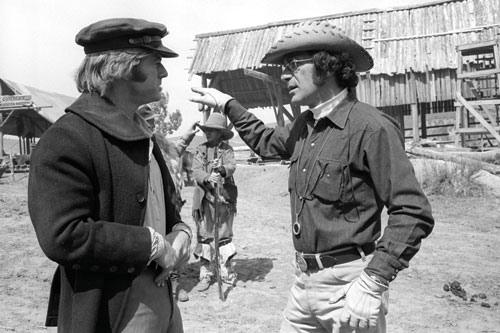 JEREMIAH JOHNSON (1972): Pollack and Robert Redford on
JEREMIAH JOHNSON (1972): Pollack and Robert Redford on
location in Utah. (© Photo courtesy Warner Bros. Pictures)Q: What about lenses, do you have any favorites?
A: They undergo revolutions just like any other aspect of photography: they get faster and lighter in weight. But even individual lenses have their own special characteristics–you can’t say every 135 lens is like every other. Sometimes you get one lens that just has glorious face tones. I used the same lens on Nicole Kidman’s face for every single shot of The Interpreter, but I didn’t use it on Sean Penn. Everybody I know gravitates towards extremes in lenses–they like long lenses and very wide lenses because those have strong, vivid characteristics. The lenses in the middle are more like life, but they’re the subtle ones, the most difficult ones to use well. It’s not hard to make a shot look interesting if you stick a 11mm lens on a camera and put it on the floor, or take a 1000mm lens and shoot through something. But the hardest part, like anything else in life, is to find the way that’s not so extreme and create a sense of theater with that.
Q: Do you shoot quickly or slowly?
A: It depends who you talk to (smiles). I probably do fewer takes than anybody else I know. If I had anything to say about it, I’d do one take. I don’t like to do a lot, I really don’t. But I don’t think I’m super-fast. My slowness comes in two forms. The first is the rehearsal process with the actors. I’m not very good at doing two or three weeks of rehearsing before a picture starts. I rehearse right there before I shoot and sometimes that can last an hour or two. The other thing–and this is not pointing fingers–is that I’ve always worked with extremely fussy and detailed cameramen. When you work on movies that cost a large amount of money, everyone works very, very carefully. My time isn’t spent on endless takes; it’s mostly spent on rehearsing and lighting.
Q: You once said that you wondered about “the mojo” Elia Kazan whispered in actors’ ears. What mojo do you use?
A: That’s something you discover as a director–what buttons you can push and how you can help an actor get to the right place in a scene. There’s only a certain amount of that you can do aloud in front of others. Some you have to do in private. For a two-person scene, you do a certain amount of rehearsing, then go into the makeup trailer and talk to one person for a bit, then go into the other makeup trailer and talk to the other person. They don’t necessarily need or want to know what you’re saying to the other. With a really good actor, you ask the right questions or give the right move or guidance and that’s really all. Timing is a big thing with actors. You don’t ever want to over-rehearse, but you don’t want them under-prepared either. Part of the trick is knowing when to roll the cameras. So many times I’ll see a performance peak during the rehearsal process and they never quite get it back. That’s why I’d rather be rolling early.
Q: You’ve worked with Barbra Streisand and Sean Penn, among many others. Generally speaking, how do you deal with strong personalities on the set?
A: I don’t think there’s a technique to handling actors: what you try to do is not lie, do your homework, be prepared, and don’t pretend to know more than you know. Theoretically, it’s your job to guide. If you’re going to have a power struggle with an actor about who’s in control of the picture, you’ve already lost. It shouldn’t happen, and in the right case it won’t. If you have an argument with an actor, there are only three possibilities: either they’re right and they convince you, or you’re right and you convince them, or you find some middle ground. And all three cases are perfectly acceptable.
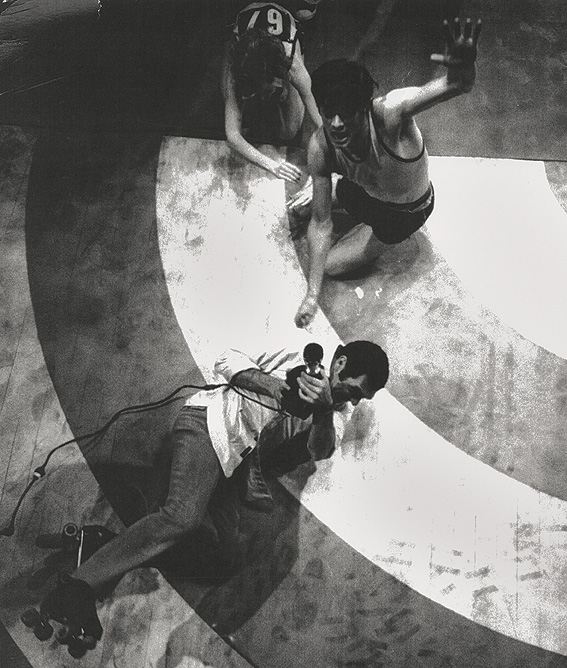 THEY SHOOT HORSES DON'T THEY (1969): Pollack put on roller
THEY SHOOT HORSES DON'T THEY (1969): Pollack put on roller
skates to shoot Jane Fonda and Michael Sarrazin during the
dance marathon. (© 1969 Palomar Pictures Corporation)Q: Is there anyone you’ve seriously butted heads with? Did you ever argue with, say, Robert Redford?
A: I’ve had disagreements with everybody, but not screaming matches. I’ve only had that with one actor: Dustin [Hoffman] on Tootsie. We had a lot of arguments about choices of behavior in scenes. Originally, the project belonged to him and it was his vision. Then I took it over and, as much as I could, I made it into my vision. And those two visions weren’t always in sync. We had a territory battle for a while, because we were transferring ownership. He has a slightly bawdier sense of humor than I do. He also wanted the movie to be more about the truths of actors’ lives than I did. I don’t say I’m right or he’s right. I just saw it in a different way than he did, and we fought like hell. But we fought for the first half hour of the day, and when we started shooting we didn’t fight and we did the scenes.
Q: Tootsie is your only full-tilt comedy, though other films have their comedic moments. It was such a commercial and critical success, why don’t you work more in that genre?
A: People don’t write good ones. I hate dumb comedies, and they’re very much in vogue now. I love to laugh as much as the next guy, but I’m not crazy about dumb jokes and it’s very tough to do a smart comedy. I would do it in a second; I would kill to do another good one. We worked our butts off on Tootsie to get it to where it is, and it was improved enormously with all the rewrites done by Larry Gelbart and Elaine May. I don’t mind the work, but where do you find great comedies today? A comedy that’s sharp and has something on its mind is worth its weight in gold. But they’re very hard to find.
Q: You’ve directed Redford in six films. What advantage does that bond give you on the set?
A: You’re not wasting any time getting to know somebody or playing the game of learning how much jockeying for position you have to do. You don’t have to ask what the actor requires, or do they need stroking, do they need lots of preparation, do they need to be pushed a little bit. You get to know where the hot spot is in your actor’s brain that’s going to make them come alive. There’s terrific efficiency, plus the comfort factor. Any creative act is an intimate act, and it’s difficult to be intimate with strangers. The real creative part of moviemaking is very revealing of yourself, the actors are very revealing of themselves, and you’re making choices that are exposing yourself in a certain way. That’s why it’s so painful to be ripped apart in a review, because in a sense you feel you’ve undressed in front of the world and they’re saying ‘oh, that’s ugly.’
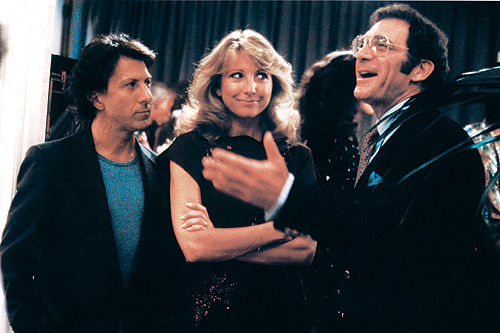 TOOTSIE (1982): Pollack's only comedy, with Dustin Hoffman
TOOTSIE (1982): Pollack's only comedy, with Dustin Hoffman
and Teri Garr. (© AMPAS)Q: The Way We Were is an intimate love story, even though its narrative jumps in time. A lot of directors shy away from flashbacks, but you use them fairly often. What’s the attraction?
A: I don’t know why people shy away from them. They make all kinds of rules like that–many shy away from narration and I don’t. Some of the best films I’ve ever seen use it. A dead body narrates Sunset Boulevard and it works. There just aren’t any ‘rules.’ I’m not necessarily attracted to or not attracted to flashbacks. But the attraction of anything that’s non-literal is that you don’t have to be linear. You get a great deal of freedom when you don’t have to progress in a realistic way. Flashbacks sometimes allow you to be extremely choosy about time and the moment. It’s like you can get the frosting of the cake, and you don’t even have to have the cake.
Q: Three Days of the Condor was based on a book about spies and heroin smuggling. You changed it to a plot about invading the Middle East for oil–and this was back in 1975. I won’t ask about your prognostication skills, but do you enjoy adapting books into films?
A: I don’t have a preference for original screenplays or adaptations. In almost every movie I’ve done, I’ve had a first draft of a script whether it’s something based on a book or not. With Three Days of the Condor we got lucky. The plot of the book was kind of corny, as were the characters. It was intended as a quick-read-in-the-airport book. But what it had was an incredible set up. So we borrowed that and created a whole new plot. The oil thing really came out of nowhere, and we didn’t know then if it was far-fetched or not.
Q: With Out of Africa you had some of the most incredible scenery on the planet. Do you prefer shooting on location or on a set?
A: That’s a question that doesn’t mean the same thing that it meant 20 years ago. Shooting on a set versus shooting on location back then meant: do you go to the real place or shoot on the back lot? You can’t shoot on a back lot today, unless you do what Marty [Scorsese] did on Gangs of New York and build a whole city. You can’t fool audiences anymore–if you want to shoot on location, you have to go there. Location today means: do you want to deal with the lack of sophistication in a Third World country in terms of the movie business? But there isn’t any way I could have shot Out of Africa anywhere but in Africa–it was the music and the place of the film. The same is true of a movie like Jeremiah Johnson. Without the majesty of those mountains, the mystique of the picture wouldn’t work. On other movies, you can switch locations and it doesn’t make a damn bit of difference. Absence of Malice could have been made in New York, San Francisco or Florida. It’s not about place; it’s about an idea and a couple of characters.
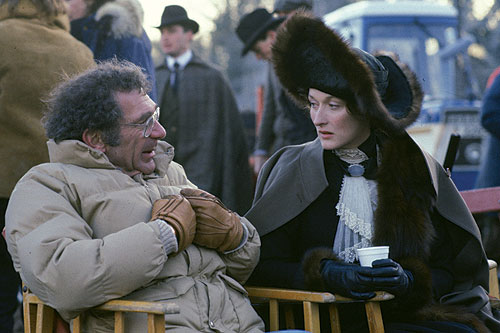 OUT OF AFRICA (1985): Pollack on the set with Meryl Streep.
OUT OF AFRICA (1985): Pollack on the set with Meryl Streep. 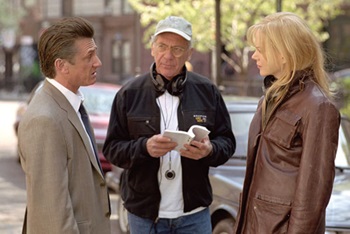 THE INTEPRETER (2005): Pollack on the set with Sean Penn and
THE INTEPRETER (2005): Pollack on the set with Sean Penn and
Nicole Kidman. (© Universal Pictures) Q: How big a role does music play in plotting out your films?
A: A very big part. I try to work on the script while listening to certain things that make me feel at home with the world of the picture. I have thousands of songs on my laptop and iPod–classical music, old standards, film scores by Morricone and Jerry Goldsmith, vocalists like Sinatra, Coldplay and some newer rock bands, pretty much everything but heavy metal. I always worry if I can’t hear the score, and that happened on The Firm. I didn’t want one of those “thriller” scores [hums ‘da, da, da, DAAAAA!’] but I didn’t know what to do. The only idea I had was that the film was set in Memphis, so I thought of the blues. I knew Dave Grusin plays blues piano, but there was other stuff–chases, love scenes–and the blues would only work for some of it. Trying to avoid the trap of a conventional thriller score, I wondered if we could do a whole soundtrack just using the piano as an orchestra of sorts. I told Dave he could do anything he wanted with the piano–kick it, bang it, pluck the strings–but he couldn’t use any other instrument. He was excited yet skeptical at first. What he did was astounding.
Q: Do you get extremely involved in the editing process?
A: Very, very involved. That’s really where the film gets made. Particularly “behavior films,” where tiny details of the performance need to work. I’m not good at editing while I’m shooting. They’re two different processes to me, and I can’t quite discipline my brain to do both of them at the same time. While I’m shooting, I’m searching for something. Then, in the editing, it becomes like sculpting. Editing is the process I enjoy the most. It’s the one time when you’re alone and you don’t have to go through an army of 200 people to get what you want. On the set, I have to go through a cinematographer, a gaffer, a production designer and use the right lens, the right camera movement, the right lighting, the right clothes, and so many specific practical disciplines to translate my subconscious wishes. What you want to say to everyone is: ‘Can’t you just reach into my brain and do what it is that I’m daydreaming?’ When you’re editing, you’re in a dark room, you can try anything you want and it’s instantaneous. Command-Z, and it’s done.
Q: You’re a founding member of the Sundance Institute and you just finished a documentary that cost all of one million dollars. Are you working on more low-budget indie-type projects now?
A: That’s about all I’m doing now as a producer [with partner Anthony Minghella]. We have four films in postproduction and they’re all in the $15 million to $20 million range. If I could find the right one, I’d love to direct a small movie. I’ve read some interesting scripts that I’m trying to develop. It’s not fun anymore to make movies that cost so much money they have to outgross the national debt to be considered successful. With advertising costs and interest today, once you start making movies at $70 million to $100 million, it’s just crazy. The numbers aren’t making much sense anymore. Pursuing those tentpole blockbusters, you face enormous risks and when it doesn’t work it’s disastrous. The only business that’s making sense today is the small independent film business.
Q: Now that you’ve done the Gehry film is there anything about documentaries that might inform your work the future?
A: I hope so. There was something marvelous in the looseness and freedom of the Gehry documentary that made me wish I had done it 20 years ago. There are principles that you learn that you can incorporate into feature filmmaking that contribute a lack of slickness and an openness to accidents. I found it a very edifying thing to go through.